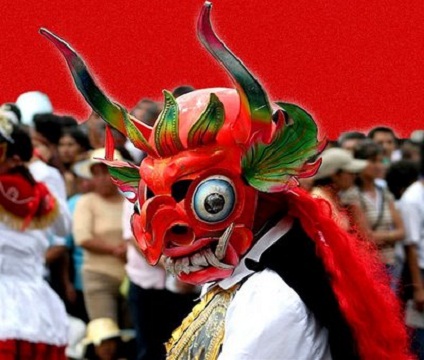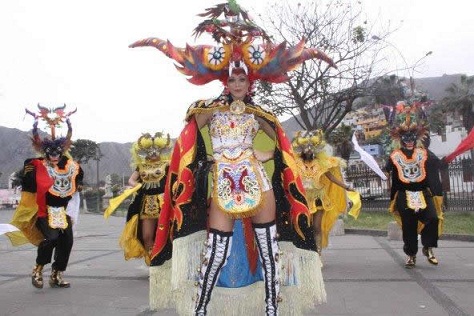La Devilish - the one that Bolivia claims as being cultural owners - is a dance that is named for the mask and devil costume that the dancers wear. Indeed, this dance is one of the most colorful during the festivities in honor of the Virgin by La Candelaria in Puno, which is celebrated in February.
The dance represents the confrontation5 between the forces of good and evil, mixing both elements of the Catholic traditions introduced during the Spanish conquest and ancestral Andean rites.
Large metal masks weigh so much that only the strongest people are capable of playing the part of the devil. The "Grand Parade" takes place on February 9 and is the height of the festivities. The groups parade in the Santos Ballon Stadium in Puno that groups bands, along with many more groups from the neighborhoods, all in exchange for a procession down the street in front of the Virgin.
The entire city becomes the setting for the five-kilometer parade through the city, starting from the banks of Titicaca and ending at the city's cemetery. This process takes between 4-6 hours depending on the crowd between dances, parades, chicha drink and unrivaled hubbub.
It is estimated that in February Puno welcomes no less than 20 thousand visitors, including national and foreign tourists. This year there was a notable lack of foreign tourists, as the floods in Cusco and the closure of Machu Picchu, obviously, has affected the plans of many people.
Today the vast majority of costumes are made directly in Puno. Embroiderers say they have the capacity to meet the demand of the Candelaria dancers, as well as other festivities in the region. The truth is that La Candelaria is like a great fashion show, where they showcase their innovative and creative work, and take orders for the following year and other groups.
It's big business, too! A suit can cost several hundred dollars, which is a very high percentage of the annual salary in the region. And with a dance group of several hundred people, the embroiderers have to work hard during the year.
There has been a slow evolution of the costumes, with the most famous, the Diablada, beginning with just a few staggered embroidered figures, perhaps with a bit of Inca history behind them. Today these costumes are embroidered with Chinese dragons and snakes, with a strangely oriental mythology and flavor, which seems a bit strange, in the Andes of South America.
This has been the result of Japanese and Chinese immigrants, who began to settle in neighboring Bolivia, and bring their embroidery skills along with a mix of their culture.
The final event of the Candelaria, is a music parade with about 1.500 musicians and dancers, consisting of 15 groups of sicuris, consisting of about 100 people in each band.


And it is something unfortunate that nowadays they always mention as unnamed Peruvian dances that he was born in Oruro - Bolivia.